The Banana Ball Python is a type of ball python morph that is famous for its strong yellow colored blotches and dark freckles.
Banana snakes are selectively bred from the West African ball python species to produce a beautiful yellow and tan patterning.
They are very easy to handle, have a docile nature, are very hardy and beginner friendly.
Despite the first clutch of Banana Ball Pythons selling for $25,000 in 2003 they are now much more affordable and can be purchased for $150.
Want to learn more? Keep reading to learn how to care for your own…
What Is A Banana Ball Python?
Banana Ball Pythons are a type of Ball Python morph that are loved for their yellow spots over a brown or tan body.
The banana morph originated naturally in the wild – but is very rare.
Will Slough first bred a banana morph in 2003 and sold snakes from the clutch for over $20,000. However, as sales increased throughout the start of the 21st century the price dropped to $150.
There are over 20 different types of banana morphs that are loved for their fun coloration and docile nature. Some of the most popular are:
- Banana pied.
- Banana spider.
- Banana clown.
- Banana cinnamon.
- Black pastel banana.
Ball pythons are a constrictor snake.
They are non-venomous and suffocate their prey instead of poisoning with a bite.
Like many pythons this snake originates from West Africa so they are used to high temperatures and short rainy seasons. Their enclosure should be large (over 30 gallons), have warm temperatures, high humidity, and many spots to hide.
Many West African tribes revere the Ball Python and consider them symbolic of the Earth. If a ball python is killed, it is given an honorary funeral.
Banana ball pythons can be spooked by any sudden movement. However, they can learn to enjoy handling as long as you ease them into it and take your time. They can get stressed if handled too much.
The ‘ball’ part of their name is because of the shape this snake makes in defense. They curl up into a little ball with their head in the center when they feel threatened or stressed.
Because they are easier to handle than other snakes they are considered a good choice for beginners.
Finally, they are hardy reptiles that don’t encounter many major health problems and can live for 30 years.
What We Like About Banana Ball Pythons
Pros
- They come in a beautiful banana-like appearance with yellow spots on a tan body
- Ball pythons are hardy snakes that are low maintenance and easy for beginners to care for.
- They have incredibly long lifespans with an average of between 20 to 30 years.
- This morph can come in a wide variety of colors and patterns.
Cons
- They require lots of practice and patience for them to be handled.
- This snake needs a large enclosure (ideally over 60-gallon).
- They eat a pure rodent diet. They are not suitable pets if you are squeamish about feeding whole rodents.
Banana Snake Appearance
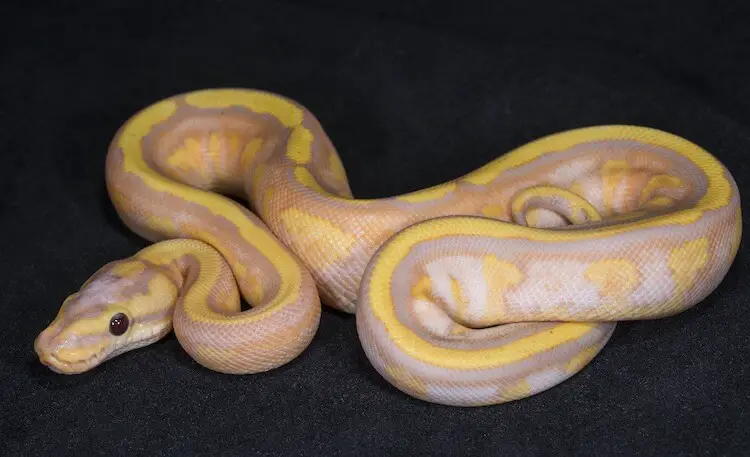
The Banana Ball Python is a morph selectively bred from Ball Pythons.
They are easily identified with a tan body and yellow spots.
Their coloration is due to an incomplete dominant genetic mutation.
They have very stocky bodies, a small head, and very smooth scales. They shed every four to six weeks, and while shedding their scales will loosen and their eyes become milky.
Color Variations and Markings
There are many different varieties of Banana Ball Pythons.
The most common color is strong yellow blotches and dark black freckles against a tan base color – this gives them their banana appearance!
A coral glow ball python looks very similar, but they have a pinkish base not tan. Genetically these two morphs are the same but the lines originate from different breeders.
Banana Ball Python Size
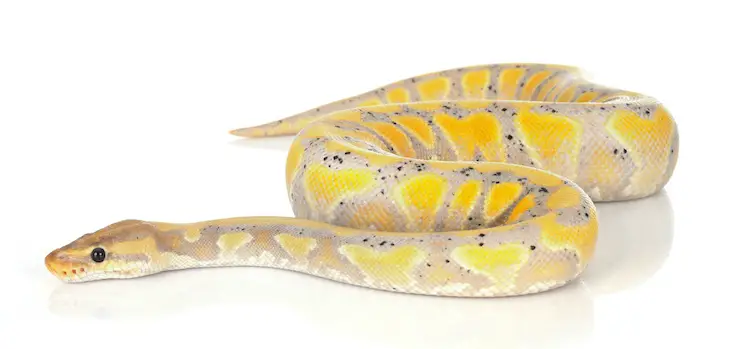
The only difference between males and females is their size.
Both snakes are classified as medium-sized however females are larger than males. Males grow to be two or three feet in length and females are three to five feet.
Baby and juvenile ball pythons are similar in size and weight regardless of their gender.
The typical growth rate is one foot each year for their first three years.
| Age | Male | Female | ||
|---|---|---|---|---|
| Baby | 1ft | 45 to 70 grams | 1ft | 45 to 70 grams |
| Juvenile | 2ft | 200 to 700 grams | 2ft | 200 to 700 grams |
| Adult | 2ft to 3ft | 1,000 to 1,500 grams | 3ft to 5ft | 1,000 to 1,750 grams |
Banana Ball Python Care Sheet
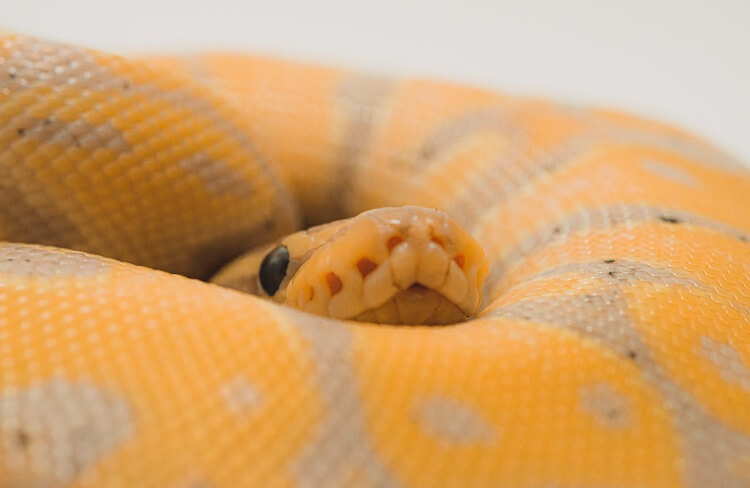
Banana Ball Python Diet
This snake is a carnivore so they only eat meat.
In the wild, they crawl along the desert floor and hunt for mice.
You should only feed Banana Ball Pythons rodents in captivity. Make sure the mouse is not wider than the widest part of your snake’s body.
You may want to give your ball python live rodents to “hunt” and provide them with enrichment. However, feisty mice may hurt your snake.
It is best to thaw and feed frozen mice instead. Make sure the rodent is warmed to room temperature before feeding:
- Juveniles and baby pythons should be fed a single rodent every 5-7 days.
- Adults need a single mouse every 7-10 days.
When feeding a rodent do not use your hands.
You should use tongs and a gloved hand to feed your snake. This will make sure your snake does not bite you during feeding.
The time it takes your snake to eat can vary widely, so give your python about 12 hours with its meal before removing it.
A water bowl is also critical for of your ball python’s diet and health.
You snake will use the bowl to drink and soak. It should be large enough to soak the entire snake, but not so large they can get stuck in it. A wide and shallow bowl is best.
Provide fresh, clean water for your snake every day.
Ball Python Lifespan and Health
The banana ball python lives a very long life. Their lifespan is very long for snakes and they will live for 20 to 30 years.
This snake does not need to be quarantined because they are solitary pets. They can go straight into their own enclosure.
Ball Pythons rarely get sick but can suffer from some health problems in captivity because of poor husbandry:
- Respiratory infections are normally caused by a dirty cage or incorrect humidity levels. It is characterized by open mouth breathing, wheezing sounds, or mucus from its nose or mouth.
- Mouth Rot can be caused by bacterial infections in their mouth. It must be treated by vet-prescribed antibiotics. Symptoms include a smelly mouth, pink or redness around the wound, and mucus drainage from the nose and mouth.
- Skin infections are easy to identify and easy to treat with a snake-safe spray. Mites and ticks are visible to the naked eye and look like small, moving black dots on your snake’s skin.
- Finally, weight management is very important. Overweight morphs have a large middle section and scales spread around their neck revealing skin. Anorexia can be common for ball pythons.
Signs They Are Healthy
- Eats regularly.
- Alert and active.
- Smooth and healthy skin.
- Bright eyes.
Sickness Symptoms
- Refuses to eat.
- Labored breathing.
- Rubbing their head.
- White substance in mouth.
Banana Ball Python Enclosure
These pets are naturally found in the West African Desert, however they are very hardy and highly adaptable to life in captivity. Banana Ball Pythons are not very active snakes and will feel insecure in a tank that is too large.
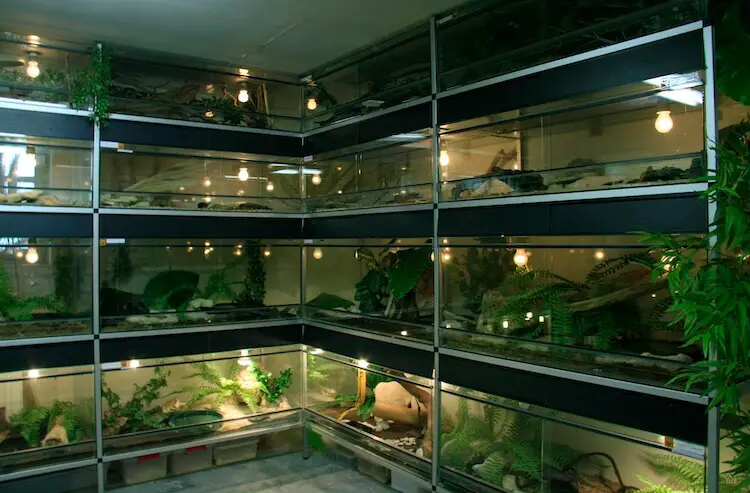
What Size Tank Should I Get For A Ball Python?
Your enclosure should grow with your python. A hatchling’s enclosure should be 10-15 gallons, a juvenile’s 15-20 gallons, and an adult’s 30-60 gallons.
A quick guide is the enclosure should be as long as your adult, with a width and height a quarter of the snake’s length.
- Tank Type: plastic or glass cage.
- Tank Size: 60-gallons.
- Lighting: basking light.
- Substrate: cypress mulch or orchid bark.
Banana ball pythons can live in many different types of enclosure. Just make sure it has good ventilation and a secure top.
Ball pythons like places to hide in captivity.
You should have at least two hide-holes in their enclosure.
You should use a substrate that allows them to burrow and holds humidity well without being too damp too. A good choice is either cypress mulch and orchid bark. Avoid any cedar wood as it is poisonous and sand can be irritating if inhaled.
Heating their enclosure is very important. You can use heating mats, basking lights, or ceramic heat emitters. Whatever you use, make sure that your snake can’t touch the heating element as it can burn itself and cause skin damage.
The warmer side of the enclosure should be between 80-85°F and the cooler side 75-80°F. Use digital thermometers at both sides of the tank to make sure the heat gradient is correct.
They should also have a basking spot with a temperature of 88-92°F. A basking bulb with UVA can also provide it with sunlight nutrients.
Having a designated basking spot is important to create a targeted warm spot and a temperature gradient, allowing your snake to thermoregulate by choosing the desired temperature.
Use a white or clear light in the daytime and red light at night to provide your snake with a 12 hour day/night cycle.
The humidity of their tank should be kept between 50-60% humidity. If your cage is too dry, try adding a room humidifier, misting daily with a spray bottle or put their water dish closes to the basking lamp.
Cleaning & Misting
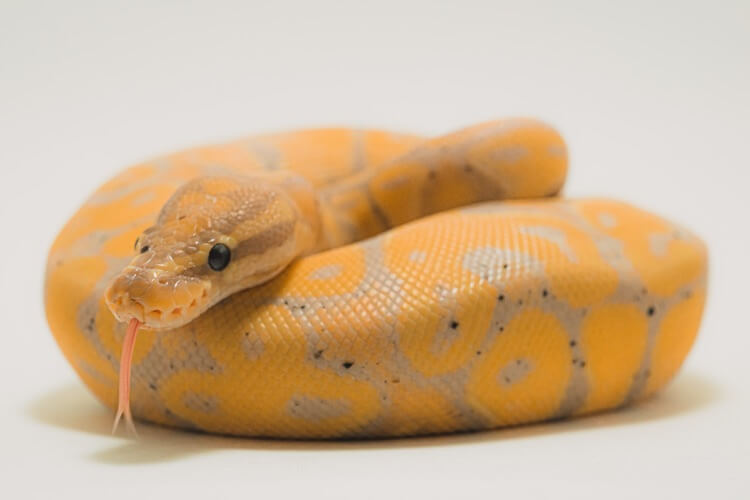
You should spot clean their enclosure each day removing any feces.
Healthy urates are white and pasty, and feces are light brown to black with a medium consistency and some hairs. Runny or clumpy feces could indicate an infection.
The water bowl should be cleaned once a week with soap and water.
Deep clean the enclosure and accessories with a 5% bleach solution about twice a month. Bleach is toxic to snakes, so make sure your snake is not exposed to it.
Typical Behavior
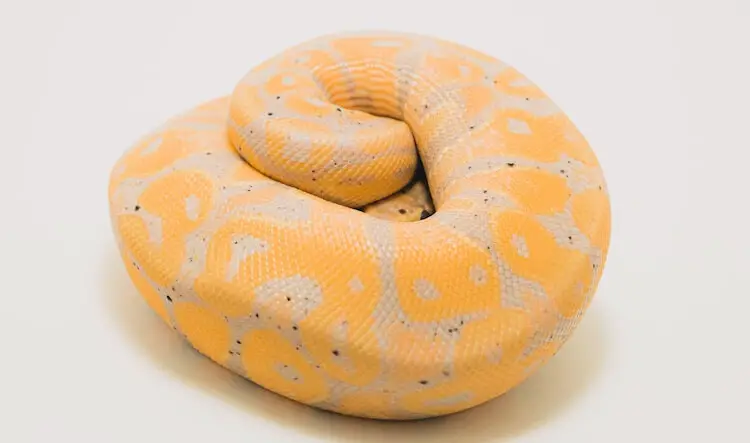
A happy and healthy banana snake will move slowly but with purpose. They use their forked tongue to gather information about their environment.
Ball pythons rely on visual cues, vibrations, and chemical traces to gather information about their environment. They also use ultraviolet light or scent to track their prey.
They are nocturnal and will burrow to hide in the dry months. This snake will only come out in the day to bask.
When stressed, they will curl into a ball and hiss at the aggressor. They are defensive animals and will roll into a ball to protect themselves.
Ball pythons rarely bite but can lash out if stressed. If your snake is already defensive, it may be more likely to lash out. They are not venomous, so if bitten, wash and disinfect the wound, treating it like a cut.
Adult pythons are territorial, so cohabitation is not recommended for this pet.
Banana ball pythons are very solitary snakes and only come together to mate.
Do Ball Pythons Like Being Handled?
Yes. Ball pythons are docile and will tolerate handling, but only in moderation.
When you first bring a python home, leave it alone for a week to get used to their new enclosure. Once it has become acclimated, handle once a week to build trust. Once you have gained trust you can start to handle more frequently.
Start handling by washing your hands with soap and water.
When handling your banana ball python don’t squeeze it and remain fairly still. Too much pressure or movement can make this snake nervous.
Juvenile banana ball pythons are timid, but handle them regularly and they will become accustomed.
Avoid handling for a day after your python has eaten, because it needs time to properly digest its food.
Baby Banana Ball Python
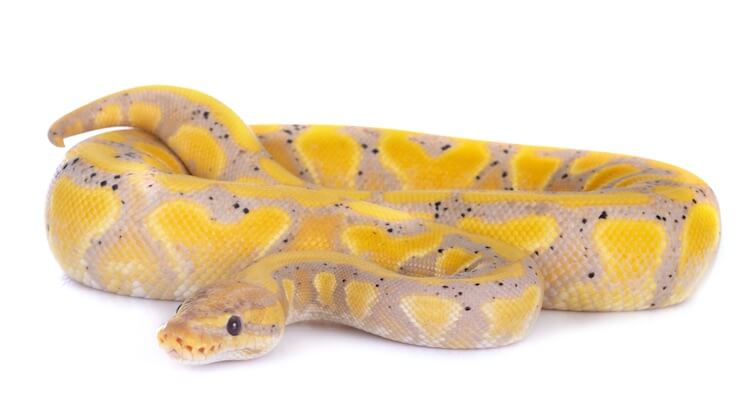
Baby banana ball pythons are born from eggs.
These eggs are around three inches wide and weigh between 70 to 100 grams.
They will adhere to each other until four days before hatching.
The temperature of the tank will not affect the sex of the hatchlings, but a female will only brood eggs in 86-88°F heat and high humidity.
Breeding occurs annually and produces clutches of between 1-11 offspring.
Mating is very difficult for ball pythons and is typically triggered with environmental cues such as fasting and dropping temperature.
Once hatchlings leave the shell, they should be separated from each other to avoid fights.
Babies won’t eat until after their first shed at two weeks of age. They typically grow a foot a year for the first three years of their life. As they age their colors will darken but they will retain their yellow banana spots.
Buyer’s Guide
It is very easy to find basic Banana Ball pythons.
Try to buy your snake from a ball breeder in person. A healthy snake will have clear eyes and a rounded body, without any bones showing.
Ask to handle the snake to get a feel for their temperament. A calm snake will move purposefully and be alert, frequently flicking its tongue.
If it’s stressed, it will curl up in a ball and hiss – a constantly stressed animal is a sign of a poor handler.
How Much Is A Banana Ball Python?
The average banana ball python is $100-$150 for a baby. Adults sell for $200-$300. The most expensive morphs (e.g. scaleless bananas) can cost $3,000.
| Banana Ball Python Facts | |
|---|---|
| Scientific Name | Python Regius |
| Price | ~$150 |
| Size | 2 – 5 feet long |
| Lifespan | 20 to 30 years |
| Diet | Only rodents |
| Tank Size | 60 – 100 gallon tank |
| Humidity & Temperature | Temperature: 75 – 96°F Humidity: 50 – 60% |
| Popular Alternatives | California King Snakes, Kenyan Sand Boa and Milk Snakes. |
Summary
The banana ball python is the second most popular ball python morph and is loved for its strong yellow-colored blotches and dark freckles.
They are very beautiful snakes that are great for beginners.
Make sure your pet is eating a regular diet of rodents and has a warm enclosure with a temperature gradient of 75 – 96°F and a humidity of 50 – 60%.
They are docile but don’t enjoy being handled too frequently. Respect your snake’s boundaries and leave them alone if they seem stressed.
When purchasing this morph make sure they are calm and alert.
Let us know what you think about this ball python morph below.

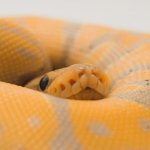

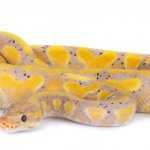
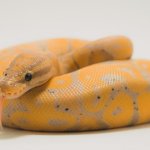
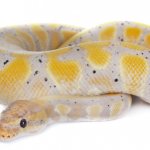
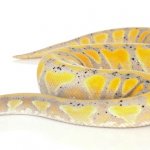
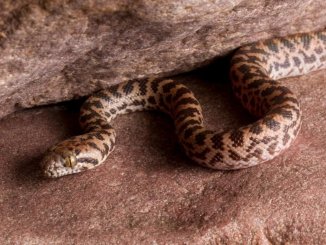
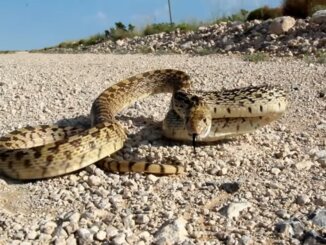
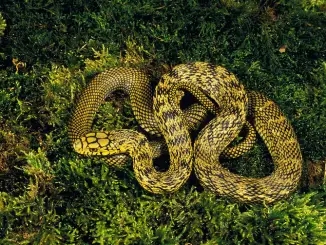

We found a banana ball in my mom’s yard and she was maybe a month old as she was a baby in September. I’ve had years of snake experience and your article is spot on. ?
Absolutely beautiful morph. I can’t stop looking at him and every time I notice something different with him. Such a great “attitude” to match. Not only did he eat while shedding, but also let the fiancé handle him as well.
I want to get one so bad and my mom won’t let me. I’ve tried everything and she won’t let me, I’d even pay for it and she said no
My name is Rachel I have a banana pastel ball python that’s a male he is about 2 to 3 months old and a female ball python she is almost 1 years old I am look for someone to have there snakes breed with mine eventually.
Got one a couple days a go. He’s only a couple months old and he absolute loves moving around and being handled.